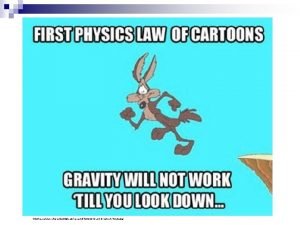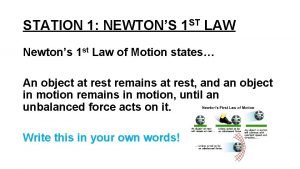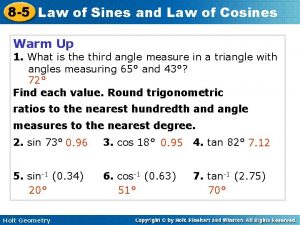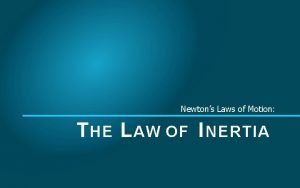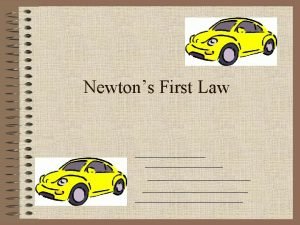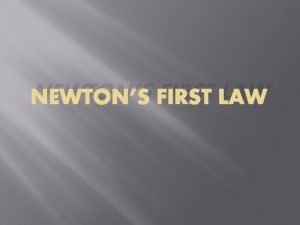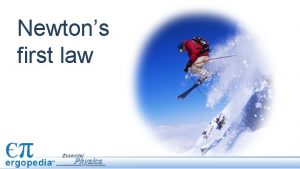Chapter 4 part A Newtons First Law Newtons









- Slides: 9

Chapter 4 – part A Newton’s First Law Newton’s Second Law

The Dynamics n

Question A ball is held in a person’s hand. a) Identify all the external forces acting on the ball and the reaction to each. b) If the ball is dropped, what force is exerted on it while it is falling? Identify the reaction force in this case.

Exercise 4. 3 n 3. A 3. 00 -kg object undergoes an acceleration given by m/s 2. Find the resultant force acting on it and the magnitude of the resultant force.

Exercise 4. 4 4. Two forces, N and N, act on a particle of mass 2. 00 kg that is initially at rest at coordinates (– 2. 00 m, +4. 00 m). (a) What are the components of the particle’s velocity at t = 10. 0 s? (b) In what direction is the particle moving at t = 10. 0 s? (c) What displacement does the particle undergo during the first 10. 0 s? (d) What are the coordinates of the particle at t = 10. 0 s?

Exercise 4. 6 6. A 3. 00 -kg object is moving in a plane, with its x and y coordinates given by x = 5 t 2 – 1 and y = 3 t 3 + 2, where x and y are in meters and t is in seconds. Find the magnitude of the net force acting on this object at t = 2. 00 s.

Exercise 4. 8 8. Three forces, given by N, and N act on an object to give it an acceleration of magnitude 3. 75 m/s 2. (a) What is the direction of the acceleration? (b) What is the mass of the object? (c) If the object is initially at rest, what is its speed after 10. 0 s? (d) What are the velocity components of the object after 10. 0 s?

Exercise 4. 20 20. Figure P 4. 20 shows a worker poling a boat—a very efficient mode of transportation—across a shallow lake. He pushes parallel to the length of the light pole, exerting on the bottom of the lake a force of 240 N. The pole lies in the vertical plane containing the keel of the boat. At one moment the pole makes an angle of 35. 0° with the vertical and the water exerts a horizontal drag force of 47. 5 N on the boat, opposite to its forward motion at 0. 857 m/s. The mass of the boat including its cargo and the worker is 370 kg. (a) The water exerts a buoyant force vertically upward on the boat. Find the magnitude of this force. (b) Model the forces as constant over a short interval of time to find the velocity of the boat 0. 450 s after the moment described.




